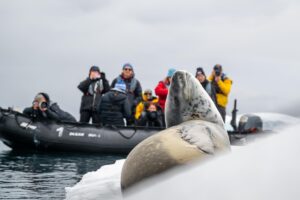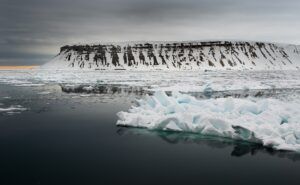There are few places on earth that capture the imagination like the polar regions. To stand at the edge of the world, surrounded by towering icebergs, curious penguins, or the silent gaze of a polar bear, is to experience nature at its rawest and most powerful. Yet timing is everything. Seasons in the poles are short, intense, and filled with transformation.
Choosing when to travel can make the difference between witnessing penguin chicks hatching in Antarctica or seeing the northern lights shimmer over the Arctic tundra. This guide takes you month by month through the polar cruising seasons of both Antarctica (South Pole) and the Arctic (North Pole), so you can plan your journey at the right moment for the experience you dream of.

Antarctica by Month
November – The Awakening
As the austral summer begins, Antarctica slowly emerges from the grip of its endless winter. Snow and ice are fresh and untouched, giving the continent a surreal, pristi
ne beauty. Penguins gather in massive colonies, performing courtship rituals and building their pebble nests. Ice formations are at their most dramatic, with towe
ring icebergs and frozen bays. For photographers, this is paradise: dazzling whites, deep blues, and pure silence.
December – Endless Daylight
December brings nearly 24 hours of sunlight, flooding the ice with golden hues. This is the height of the Antarctic summer, with temperatures rising just above freezing. Penguin rookeries are bustling, with eggs beginning to hatch. Seal pups appear on beaches, and more areas of the peninsula become accessible as ice recedes. It’s a time of energy, life, and boundless opportunity for exploration.
January – Peak of Life
The warmest month in Antarctica (though “warm” is relative at 0°C to +5°C). Wildlife activity reaches its climax: fluffy penguin chicks crowd the rookeries, fur seal pups play on the shores, and whales arrive in abundance. The long daylight hours allow extended shore excursions and Zodiac cruises, making it one of the most rewarding — and popular — months to visit.
February – Whale Season
By February, penguin chicks are growing fast, chasing parents across the snow. But the true stars of this month are the whales. Humpbacks breach, orcas hunt, and minke whales glide gracefully alongside expedition vessels. The sea ice is at its lowest, allowing ships to reach farther into the Southern Ocean. For wildlife enthusiasts, this is the ultimate month.
March – A Golden Farewell
As autumn approaches, the continent grows quieter. Penguins molt in great numbers, preparing for the long winter, while whales continue to feed before their migration north. The light softens, creating stunning sunsets that return after months of endless day. It’s a more contemplative time to visit — fewer ships, rich colors, and a sense of farewell from the White Continent.
 Arctic by Month
Arctic by Month
May – Spring on the Ice
In the far north, the Arctic awakens later. In May, migratory birds return by the millions, covering cliffs with sound and motion. Polar bears begin to roam the ice edges in search of seals. Snow still blankets much of the land, but cracks in the ice hint at the season to come. For those who long for raw, icy landscapes and the thrill of spotting the first signs of wildlife, this is a magical time.
June – The Midnight Sun
The Arctic transforms under 24 hours of daylight. Tundra flowers bloom, turning the land into a delicate tapestry of green, yellow, and purple. Sea ice begins to melt, opening fjords and passages to exploration. Polar bears are at their most visible, often spotted along the pack ice. This month combines the stark beauty of ice with the energy of life returning.
July – Summer in the High North
July is the warmest Arctic month, though still cool compared to temperate regions. With the ice retreating, more routes become possible, including attempts at the legendary Northwest Passage. Whales thrive in these waters — belugas, narwhals, humpbacks, and even bowheads. Walrus haul-outs are impressive, with hundreds of animals gathering on remote beaches. It’s a month for adventure, exploration, and remarkable wildlife.
August – Wildlife Spectacle
Wildlife reaches its peak in August. Bird cliffs are alive with activity, polar bears patrol the ice, and whales are abundant. The tundra is painted in vibrant summer colors, contrasting against the last of the retreating sea ice. This is also the month when expeditions can push farthest into the High Arctic, offering dramatic scenery and encounters at the very top of the world.
September – The Northern Lights Return
As nights return to the Arctic, so too does the magic of the aurora borealis. Imagine watching the green and purple lights dance across the sky while anchored in a silent fjord. Wildlife activity remains strong: musk oxen begin their rutting season, reindeer clash antlers, and bears still hunt along the ice. It’s the grand finale of the Arctic season, when nature puts on a final show before winter closes in.
How to Choose the Right Time?
-
Dreaming of penguins and whales? Pick Antarctica in January or February.
-
Fascinated by untouched ice and pristine landscapes? Go early in the season: November in Antarctica or June in the Arctic.
-
Want the northern lights? Choose September in the Arctic.
-
Prefer fewer crowds and a quieter atmosphere? Travel at the bookends: March in Antarctica or May/September in the Arctic.